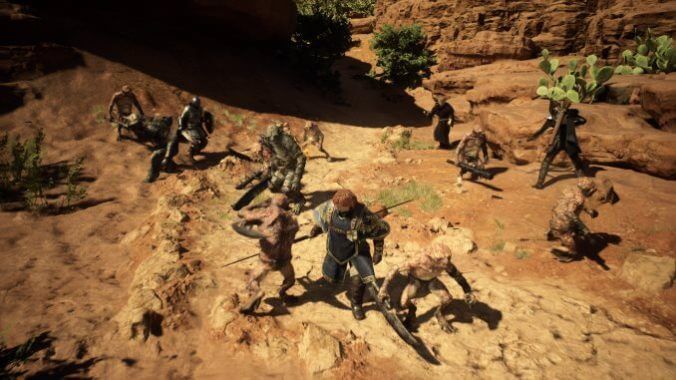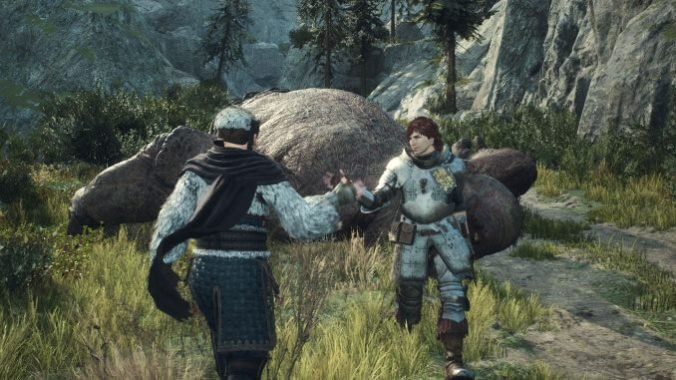After a few minutes of mucking about in Dragon’s Dogma 2, I came across a bridge that would take me to my objective. In a bid at trying to recreate some of the game’s initial trailer, I destroyed the bridge at one of the ends, severing what I would later learn to be an integral connection to the mainland. Safely on the other side, I engaged a group of soldiers being swarmed by goblins, which me and my pawns quickly dispatched before night falls. I was left with two choices here: make camp or brave one of Dragon’s Dogma’s infamous nights. I chose the latter.
A mistake in hindsight, I made my way back to where the aforementioned bridge would’ve been had I not wrecked it. In any other game, it might’ve disappeared for a time before being magically fixed offscreen so as to not inconvenience players. Not here though. In Dragon’s Dogma 2, that bridge was gone, its lingering wreckage a reminder of my errors like a stained t-shirt after a night out. It was on me to divine a path back in Dragon’s Dogma 2’s harrowing and suffocating darkness. Along this tragic journey, I guided my party further in the wrong direction than I intended, coming to a thicket of trees that were soon toppled by the rampage of a minotaur that descended on me and my allies. Tree trunks flew as I tried to bob and weave the minotaur’s charges. I guarded as best as I could, but the minotaur’s strength overwhelmed my own and I spent more time laid out than I did in the fight before an epiphany struck me.
In the thick of the action, I clambered onto the minotaur’s head and maimed its face with my sword. My pawns not only made sure I was topped on health but that my sword caught fire, so as to deal more damage. Slowly but surely, I whittled the minotaur’s health down and my NPC companions, seemingly feeling the tide of battle shifting in our favor, followed suit and joined me atop the beast. Soon enough, a number of us were hilariously crawling all over, not unlike ants, and it wasn’t long before the weight of our bodies and blows toppled it, leaving our would-be predator exposed and vulnerable. Regaining its footing, the minotaur made one last ditch attempt, even going so far as downing a number of my pawns, including my healer. With a sliver of health left, I charged in and used one of my vocation skills, Airward Slash, which sent me up into the air where my blade would soon crash down on my opponent, and with that last swipe, my hard-fought battle came to an end. To think, this was not only a detour, but a complete accident on my part: I had meant to find a way north and instead went south.
On my way back to the camp we had come across earlier, I tasked my pawn Max with guiding us to our next objective in the hope that they might finally get me across the river I could no longer seem to cross. In short, they did. A shallow stretch of rocks provided a path which we could cross in the hopes of finding our way back. It also held, at the very end of it, a den of armed lizardfolk who laid waste to me too many times to count. In my final attempt at the encounter, I ran past them as best as I could as they picked off my companions one by one. Climbing the hills behind them, I was greeted by a cacophony of bewildering sights and sounds. The air around me took on a greenish hue and the sound of explosions by the river signaled to me that the lizard’s explosive barrels had claimed another victim. I heard the roar and footfall of monsters out of my line of sight and the tinged air took ghastly shape, chased me up one last mountain where I made a defiant last stand. Unequipped with anything that could make a difference and bereft of any allies, whatever malignant spirit had found me closed in and snuffed me out. I never made it to my goal. My journey had ended in tragedy.
What a journey it was, though.

Dragon’s Dogma 2 seems like an engine primed for tales like this. Games are ballooning to be bigger than ever, but Dogma seems to be smartly making decisions that will attract players to its world without size being the major selling point. It does this by establishing as many possibilities as there are constraints. The possibility of running into that minotaur in the complete dark, all the while being ill-prepared, and being able to walk away from it triumphant with a story is a product of those measures. So is the subsequent cavalcade of unearthly terrors that spelled my demise soon after. It literally only happened because I took out a bridge, after all. Since the first game‘s release in 2012, the ability to reach out and grab a thing has been a tremendous boon in this effort. To this day, I remember the griffin from the initial gameplay reveals, and how awestruck I was at the ability to mount them, as if they were a real thing in a real world and not simply a target to strike at. Though I wasn’t lucky enough to find one myself, I did scan my neighbors—noted Dragon’s Dogma sickos Renata Price and Austin Walker—whooping it up as they found a griffin, mounted it, went for a stunning ride and were then shaken off and dropped onto the fringes of a beach remarkably intact. Interactions like these seem to be the crux of the experience; in a recently released overview of the game, a party was able to knock a cyclops over into the space between two cliffsides, forcing it to hold onto the other side and become a makeshift bridge. In another instance, leaping into the back of an oxcart enabled the player character to fast travel, but they ran the risk of being unceremoniously interrupted by a cyclops ambushing the wagon. There’s an immense weight to the player character that made me feel like I could knock anyone over if I ran into them too hard and it feels like this has been lent to everything in the world. Various elements of the world feel like they’re allowed to knock into and stumble over one another in both clean and messy ways, bestowing them a permanence and ability to permeate throughout your experience unlike most other titles I’ve played.
Dragon’s Dogma 2 is also still a blockbuster in the way most RPGs are now and so it isn’t grossly unfamiliar. The world is huge, and filled with quests to take on and characters to engage with, including your pawns. Pawns—a standout feature from the original game, where you could design an AI companion and hire other players’ customized pawns to join you—are back in Dragon’s Dogma 2 and as helpful, and chatty, as ever. Its classes and action will likely look pretty familiar too if you’re aware of the general fantasy and RPG landscape. Much of this seems more streamlined since the series’ initial outing in 2012, but fundamentally unchanged, which is great because on paper there was never really anything wrong with Dragon’s Dogma’s systems. The game was just weird and a little awkward, i.e the hallmarks of every “cult classic” from that era. Its quirks, as Digital Trends‘ Giovanni Colantonio notes, might even be more beloved now that the audience for it has been reared by recent outliers finding runaway success like Baldur’s Gate 3.
I’m now waiting with bated breath for the next time I get my hands on Dragon’s Dogma 2, if only to see how much further I can push the bounds of its emergent capabilities. I reckon the story of the game, which I got zero insight into, isn’t going to be what keeps me going. Instead, jumping more minotaurs, and maybe even finally riding a griffin, sounds like a much more appealing way to get to know the game. Maybe even get to the bottom of whatever ghost killed me at the end of my warrior playthrough. I want to see how much weirder it can get and how much more I can make its elements collide and what fun new surprises it might yield. Based on my hour with Dragon’s Dogma 2, I wouldn’t discount how wonderfully out of hand things can get.
Moises Taveras is the assistant games editor for Paste Magazine. He was that one kid who was really excited about Google+ and is still sad about how that turned out.

